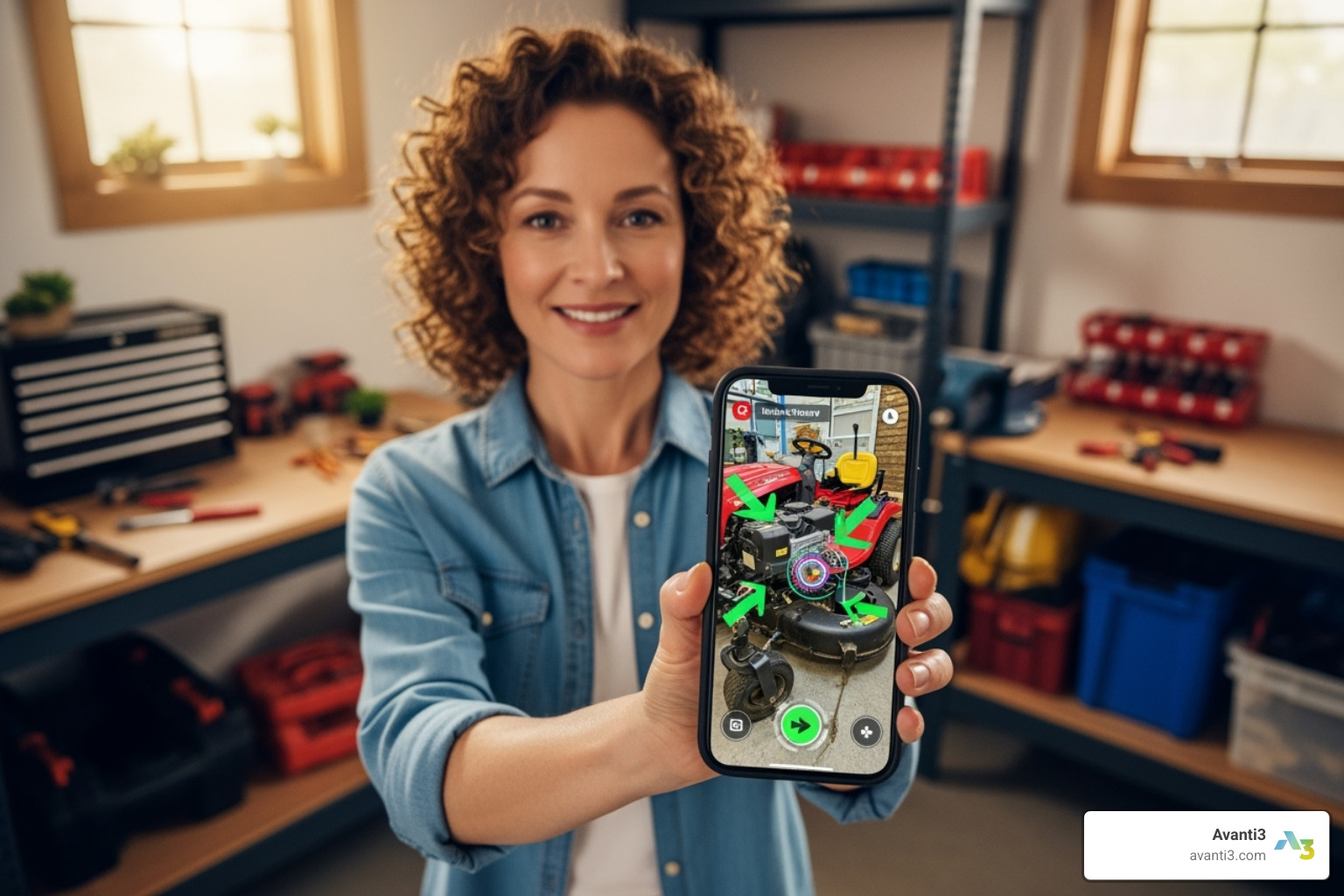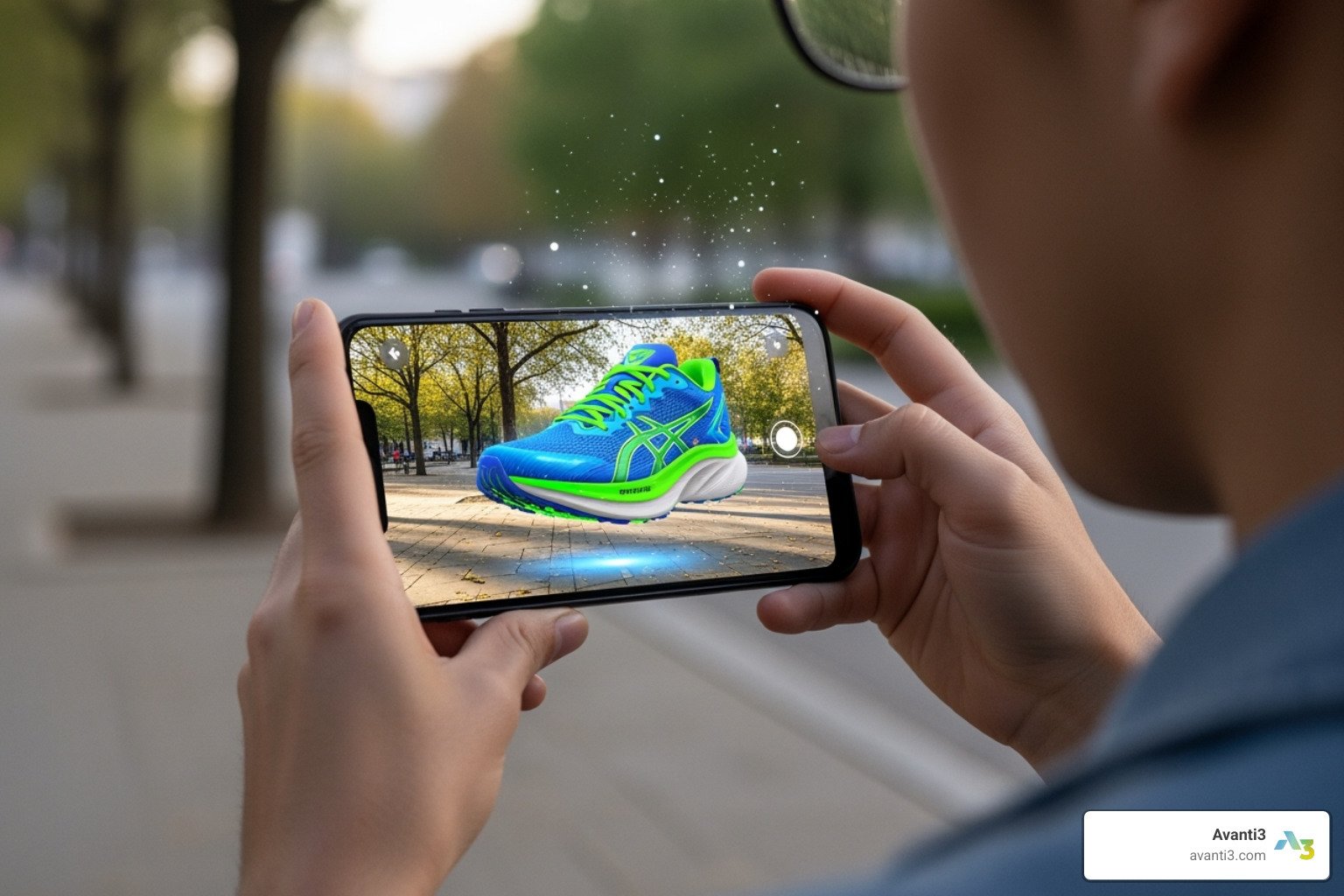Augmented reality based support solutions: Top 2025
Why Augmented Reality Based Support Solutions Are Revolutionizing Customer Service
Augmented reality based support solutions are changing how businesses deliver customer service by enabling remote experts to see exactly what customers see and provide real-time visual guidance through their mobile devices. This technology combines live video streaming with digital overlays, allowing support agents to draw instructions, point to specific components, and guide users through complex troubleshooting steps as if they were standing right beside them.
Key components of AR support solutions:
- Live video streaming – Customers share their camera view with remote experts
- AR annotations – Support agents draw directly on the customer’s screen in real-time
- 3D spatial mapping – Technology tracks objects and spaces for precise guidance
- Multi-device compatibility – Works on smartphones, tablets, and smart glasses
- Session recording – Captures interactions for knowledge base and compliance
The impact is measurable. Research shows that AR support solutions can reduce troubleshooting times by 70%, cut machine downtime by 30-70%, and save businesses up to $500 per truck roll. As one industry expert noted, “Remote support via augmented reality is fast becoming a game-changing service for today’s IT teams.”
The technology addresses critical business challenges including the skills gap (73% of organizations worry about an aging workforce), rising operational costs (unplanned downtime costs manufacturers $50 billion annually), and the need for faster problem resolution in our increasingly complex digital world.

What is AR-Based Support and How Does It Work?
Picture this: you’re facing a broken machine, stumped. Instead of waiting hours for a technician, you use your phone to connect with a remote expert who virtually guides your hands to fix the problem. That’s the power of augmented reality based support solutions.
These systems create a “see-what-I-see” experience. When you point your device’s camera at a problem, a remote expert views your live video stream. They can then draw instructions, point to specific parts, and add notes that appear right on your screen, overlaid on the real world.
The magic happens through real-time collaboration between the on-site user and the remote expert. While you handle the physical work, the expert provides the knowledge, creating a seamless partnership that bridges any distance.

The Core Technology Explained
Behind every AR support session is a symphony of technologies working together. Let’s break down what makes this possible.
Camera sharing forms the foundation, streaming live video to the remote expert and giving them eyes on the ground. Suddenly, distance becomes irrelevant.
3D spatial mapping is where things get impressive. Advanced systems understand the three-dimensional space around you, tracking objects and surfaces. This means an expert’s annotation stays perfectly positioned even if you move your camera.
Computer vision adds intelligence, allowing the system to recognize objects and components. This enables smarter assistance and more targeted guidance.
The real showstopper is the AR annotations suite. Experts can draw arrows, circles, and lines directly on their screen, which appear overlaid on your view. They can add live pointers, write text instructions that float next to components, and even overlay 3D model overlays for complex procedures.
Knowledge base integration ensures every successful repair becomes a learning opportunity. Sessions can be recorded and solutions saved, creating a growing library of visual solutions.
From Problem to Resolution: A Step-by-Step Workflow
When trouble strikes, augmented reality based support solutions offer a smooth journey from frustration to resolution:
Initial contact: A user encounters a problem and requests help through the support app, bypassing lengthy phone trees.
Session initiation: The expert sends a simple invitation. With a single tap, the user accepts, and their camera feed begins streaming without complex setup.
Visual assessment: The expert immediately sees the problem and environment, gaining context without needing verbal descriptions.
Guided troubleshooting: The expert uses AR to draw instructions and point to components directly on the user’s screen, providing clear, step-by-step guidance.
Problem resolution: Clear visual guidance leads to faster fixes, often on the first attempt, saving time and reducing frustration.
Session recording: The entire interaction is captured, serving as proof of work, training material, and compliance documentation.
Knowledge capture: Successful sessions become reusable assets saved to the knowledge base, creating self-service resources and improving organizational learning.
The Core Benefits of Augmented Reality Based Support Solutions
The shift to augmented reality based support solutions is about fundamentally changing business operations. We’re seeing dramatic improvements, from slashing costs to empowering employees and delighting customers. The fact that unplanned downtime costs industrial manufacturers an estimated $50 billion each year highlights the urgent need for solutions that keep things running smoothly.
Slashing Operational Costs
One of the most immediate benefits of augmented reality based support solutions is a significant reduction in operational expenses.
- Reduced Truck Rolls & Lower Travel Expenses: Resolving issues remotely eliminates costly technician dispatches, which can range from $150 to $500 per visit. This empowers remote experts to guide on-site personnel, leading to substantial savings.
- Minimized Machine Downtime: In industrial settings, time is money. AR support enables up to 70% shorter troubleshooting times and can reduce machine downtime by 30-70%, keeping production lines running and preventing costly interruptions.
- Optimized Resource Allocation: Experts can support multiple locations without travel, handling more cases daily. This optimizes the use of skilled personnel, freeing them to focus on the most complex issues.
Boosting Efficiency and Productivity
Beyond cost savings, augmented reality based support solutions are supercharging productivity and making operations smoother.
- Increased First-Time Fix (FTF) Rates: With a clear view of the problem, experts provide more accurate guidance, significantly improving the chances of fixing the issue on the first try. This leads to less rework and higher customer satisfaction.
- Reduced Average Handle Time (AHT): Visual guidance is faster than verbal instructions. The “show, don’t tell” approach minimizes miscommunication and accelerates problem resolution, with some companies slashing AHT by 20%.
- Faster Inspections & Streamlined Workflows: AR guides technicians through complex inspections, speeding up processes by 25-40% in some cases. Contextual information and step-by-step guidance streamline workflows directly in the field.
- Significant Productivity Gains: Across industries, organizations have reported productivity increases of up to 15%, showcasing the tangible impact of AR in optimizing operations.
For a deeper dive into how immersive technologies can transform your business, explore More info about AR/VR Immersive Experiences.
Bridging the Skills Gap and Empowering Staff
With 73% of organizations concerned about an aging workforce, effective knowledge transfer is crucial. Augmented reality based support solutions offer a powerful answer.
- Expert Knowledge Transfer: AR allows seasoned experts to mentor junior technicians remotely through visual, interactive sessions. This ensures critical knowledge is transferred and not lost to retirement.
- On-the-Job Training & Remote Mentorship: New hires get up to speed faster with immediate, contextual guidance. Companies have seen training time reduced by 50-93%, accelerating hands-on learning and reducing classroom time.
- Improved Safety Compliance: Embedding safety procedures into AR instructions ensures critical steps are followed, enhancing workplace safety. Operators receive real-time alerts and guidance, particularly in hazardous environments.
Key Industries and Use Cases for AR Support
The versatility of augmented reality based support solutions is one of their greatest strengths. Whether fixing a factory machine, installing a home appliance, or troubleshooting a network, AR support adapts to the unique challenges of each industry.

Manufacturing and Industrial
In manufacturing, where downtime costs thousands per minute, augmented reality based support solutions are lifesavers. An expert across the world can virtually step onto the factory floor to guide a local team through a complex repair, minimizing production loss.
Remote machine maintenance has become incredibly sophisticated. Experts can guide technicians through complex repairs on multi-million-dollar equipment, like in the remote maintenance of injection molding machines. Visual guidance ensures precision and reduces costly errors.
Assembly guidance is another area where AR shines. Instead of using complex manuals, workers see visual instructions overlaid on components. This approach has led to efficiency boosts of 20-30% for forward-thinking manufacturers.
For quality assurance inspections, AR transforms a tedious process into a streamlined, foolproof one. Some organizations have reported near-perfect data reliability after implementing AR, effectively eliminating manual entry errors. Inspectors are guided through detailed checklists, ensuring every point is verified.
With production line troubleshooting, experts can quickly diagnose and resolve issues by seeing the problem through an operator’s device. This leads to processes that are 25% faster in many cases, keeping production lines running.
Field Service Management
The field service industry is being revolutionized by augmented reality based support solutions. Gartner predicts that by 2025, over 50% of field service management deployments will include mobile AR, a massive jump from less than 20% in 2021.
Remote diagnostics has changed the game. Instead of a potentially unnecessary truck roll, experts can conduct a visual assessment remotely to diagnose issues, pre-order parts, and dispatch the right technician.
Guided installations are becoming popular for complex equipment. Customers or junior technicians can be walked through intricate procedures with clear visual instructions, improving first-time success rates.
Pre-dispatch surveys save time and money. Experts conduct virtual site surveys to gather information and plan interventions more effectively without travel.
Compliance audits are easier than ever. AR can guide personnel through compliance checks, ensuring all regulations are met and visually documented, creating a clear audit trail.
IT and Customer Support
In IT and customer support, augmented reality based support solutions are changing problem-solving. Visual communication is key when explaining technical concepts.
Remote IT helpdesk support is more effective when technicians can see what users see. They can point directly to ports, settings, or buttons, eliminating confusion.
Consumer electronics troubleshooting is more user-friendly. Customers get visual assistance for installing appliances or fixing connectivity issues, reducing in-home visits.
Guided self-service is an exciting development. AR-powered tutorials empower customers to solve common problems independently, reducing call volumes. This technology can be integrated into broader AR Marketing Solutions to improve the overall product experience.
The results in improved customer satisfaction speak for themselves, with some organizations reporting improvements of up to 70% after deploying visual support.
What to Look for in an AR Support Platform
Choosing the right augmented reality based support solutions platform is critical. You need a reliable, user-friendly tool that grows with your needs, not a system that looks good in demos but fails in practice.

Key Features of Effective Augmented Reality Based Support Solutions
When evaluating platforms, focus on what matters in high-pressure moments. Crystal-clear communication is the foundation; look for live HD video and audio that won’t freeze during a critical repair.
The magic happens with the AR annotation suite. Your remote experts become virtual hands, drawing on what the on-site person sees. You’ll want intuitive tools like freehand drawing, arrows, text overlays, and pointers.
3D object and spatial tracking is what keeps digital annotations glued to the right spot, even when the camera moves. It’s like having sticky notes that never fall off.
Session recording and snapshots are game-changers. Every successful repair can become a training video, and every solved problem adds to your company’s knowledge base.
The smartest augmented reality based support solutions include AI object recognition that can “see” what’s in the camera feed. The system can identify components, validate steps, and ensure safety procedures are followed.
Don’t overlook no-code workflow creation. This lets your team create step-by-step visual guides without needing to code, capturing expert knowledge before it’s lost to retirement.
Compatibility and Integration
The best AR platform is useless if it doesn’t work with your existing systems. Your solution must be compatible with the devices your team already uses: smartphones (iOS and Android), tablets, smart glasses, and other wearables.
Integration is where many companies stumble. You need open APIs or pre-built connections that link seamlessly with your current tools, whether it’s your CRM, field service management system, or warehouse management system.
Think about your daily workflow. Can your team launch an AR session from their existing interface? Does the recording automatically attach to the service ticket? These details differentiate a transformative solution from one that sits unused. The goal is to make augmented reality based support solutions a natural extension of how your team already works.
The Future of AR Support and What’s Next
The world of augmented reality based support solutions is evolving rapidly. With Gartner predicting that by 2025, over 50% of field service management deployments will include mobile AR, a fundamental shift in business operations is underway.
This change is accelerated by AR’s convergence with other breakthrough technologies like Web3, metaverse environments, and digital twins, creating new possibilities for remote collaboration. These bridges between the physical and digital worlds allow expertise to flow seamlessly across any distance.
Applications are expanding beyond traditional support, with innovative uses in Augmented Reality Marketing demonstrating how visual guidance can improve customer experiences.
The Convergence of AI and AR
The marriage of Artificial Intelligence and Augmented Reality is creating support experiences that feel almost magical.
Predictive maintenance alerts are becoming a reality as AR systems integrate with IoT sensors. AI analyzes real-time data and triggers AR-guided maintenance instructions before problems occur.
Automated step-by-step guidance is getting smarter. AI-powered object recognition enables AR systems to automatically identify equipment and provide context-aware instructions without constant expert oversight.
Intelligent search and AI-powered diagnostics are revolutionizing knowledge access. AI can quickly surface relevant visual guidance from vast knowledge bases and analyze visual input to suggest potential solutions.
As more data flows from AR support sessions, AI learns and refines the guidance through adaptive learning. This opens up fascinating possibilities, including innovative applications like Augmented Reality NFTs that could carry embedded instructional content.
The Future of Augmented Reality Based Support Solutions
Looking ahead, augmented reality based support solutions are evolving to fundamentally change our approach to technical support.
The shift from reactive to proactive support is underway. AR will enable routine inspections with AI-driven checklists, anticipating failures before they impact operations and saving businesses millions.
Integration with digital twins represents an exciting frontier. An expert could interact with a machine’s digital twin, with those actions reflected in real-time on the physical machine via AR overlays for an on-site technician.
Hyper-personalized customer experiences are becoming the new standard. AR will offer custom guidance that adapts to individual user skill levels, making self-service truly intuitive.
Broader adoption across new sectors is accelerating. Beyond manufacturing and field service, AR support is expanding into healthcare for remote patient guidance, education for hands-on training, and consumer services.
Metaverse and Web3 integration is perhaps the most transformative development. As digital and physical worlds merge, AR support will extend into metaverse environments, offering new dimensions for collaboration, similar to what we’re seeing with Augmented Reality Concerts.
The future is about creating more human connections through digital tools, making knowledge universal and instantly available.
Conclusion
Augmented reality based support solutions have evolved from experimental tech to essential business tools, reshaping customer service and operations. The results speak for themselves.
These solutions drastically reduce costs by cutting truck rolls and machine downtime, boost efficiency with faster fixes, and bridge skills gaps by enabling remote mentorship and knowledge capture. The magic is in the application: a factory worker guided by an expert in Germany, a customer installing equipment with on-screen instructions, or a new technician learning on-site from a remote mentor.
Adopting this technology provides a crucial competitive advantage where customer expectations and operational efficiency are paramount. Embracing augmented reality based support solutions now is about future-proofing your business for tomorrow’s challenges.
The landscape of customer service and technical support will never be the same. As businesses continue to innovate, leveraging technology to create powerful, engaging digital interactions is key. Avanti3 specializes in building the next generation of AR/VR immersive experiences that redefine how brands connect with their customers.
The question isn’t whether AR support will become mainstream—it’s whether your business will be ready to lead the way or scramble to catch up.








